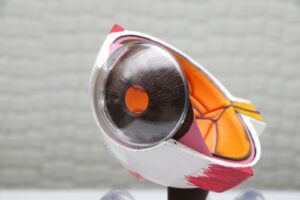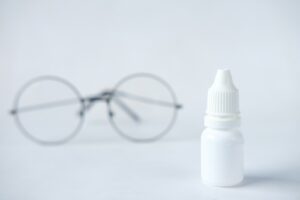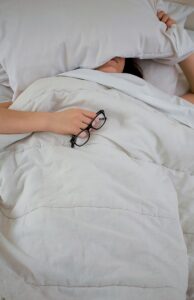Solutions for Tired-Looking Eyes: Tired Eye Treatment, Diagnosis, and Prevention
Have you ever experienced the discomfort of tired eyes after a long day of staring at screens? Understanding tired eyes is fundamental in understanding tired eye treatment. It’s essential to delve into the causes of tired-looking eyes, the symptoms of eye fatigue, and their relation to eye strain.
Understanding Tired Eyes

Photo by Katelyn Greer on Unsplash
Tired eyes encompass a range of concerns that affect the skin around the eye, such as dark circles, puffiness, and fine lines. The eyes feel fatigued due to factors like prolonged screen time, exposure to blue light, and digital eye strain. Addressing tired eyes involves caring for the delicate skin around your eyes and finding remedies to relieve them.
Causes of Tired-Looking Eyes
Tired-looking eyes can be caused by various factors, including eye strain, dry eye, and fine lines and wrinkles around the eye area. Extended screen time, failing to follow the 20-20-20 rule (taking a 20-second break every 20 minutes, looking 20 feet away), and lack of adequate hydration can contribute to tired eyes. Incorporating hyaluronic acid and using eye drops can help reduce eye fatigue and make your eyes look less tired.
Symptoms of Eye Fatigue
Eye fatigue presents symptoms like redness, itchiness, and a feeling of tiredness in the eyes. Additionally, eye strain can manifest as under-eye puffiness, dark circles, and fine lines and wrinkles. To alleviate these symptoms, consider making lifestyle changes, using an eye cream, and giving your eyes a break periodically throughout the day.
Relation to Eye Strain
Digital eye strain, characterized by symptoms such as dry eyes, blurred vision, and headaches, is closely related to tired-looking eyes. Prolonged use of digital devices can lead to eye strain and contribute to the appearance of tired eyes. Regular eye exams, adopting the 20-20-20 rule, and using protective measures to reduce eye strain are essential in preventing tired eyes and promoting overall eye health.
Diagnosing Tired Eyes

Photo by Harpreet Singh on Unsplash
Diagnosing tired eyes involves a comprehensive assessment of the factors contributing to eye fatigue. During an eye examination, an optometrist or ophthalmologist will evaluate your eye health, vision acuity, and any signs of strain or fatigue. This process helps identify underlying issues such as dry eye syndrome, refractive errors, or other conditions affecting the eyes.
Eye Examination Process
The eye examination process typically includes tests to assess visual clarity, eye muscle coordination, and intraocular pressure. The optometrist may also evaluate the retina, optic nerve, and overall eye health. By examining these aspects, eye care professionals can pinpoint sources of eye strain and fatigue, guiding appropriate treatment and management strategies.
Specialized Testing for Eye Fatigue
In cases of persistent eye fatigue or complex visual symptoms, specialized testing may be necessary. This can include assessments for contrast sensitivity, color vision, and visual field testing. These specialized tests help in diagnosing specific issues contributing to tired eyes and assist in developing targeted treatment plans.
Consulting with an Ophthalmologist
For individuals experiencing chronic eye fatigue or concerning symptoms, consulting with an ophthalmologist is crucial. Ophthalmologists specialize in diagnosing and treating various eye conditions, offering advanced care for complex eye health issues. By seeking professional guidance, individuals can receive tailored recommendations to alleviate tired eyes and improve overall visual wellness.
Tired Eye Treatment Options

Photo by Towfiqu barbhuiya on Unsplash
When it comes to dealing with tired-looking eyes, exploring various treatment options can help alleviate discomfort and improve eye health. Whether opting for home remedies or seeking professional treatments, addressing the root causes of eye fatigue is key to finding effective solutions.
Home Remedies for Tired Eyes
Home remedies offer natural and accessible ways to relieve tired eyes. Applying cold compresses, cucumber slices, or chilled tea bags can help reduce puffiness and soothe the eyes. Additionally, practicing relaxation techniques, such as gently massaging the eyelids or placing warm compresses over closed eyes, can promote eye comfort and reduce strain.
Professional Treatments for Eye Fatigue
For persistent or severe cases of eye fatigue, professional treatments by optometrists or ophthalmologists may be necessary. These can include prescribed eye drops for dry eyes, specialized therapies for eye strain, or treatments targeting specific eye conditions. Seeking expert guidance ensures personalized care to address underlying issues contributing to tired eyes.
Role of Hyaluronic Acid in Eye Care
Hyaluronic acid, known for its hydrating properties, plays a vital role in eye care. By retaining moisture and promoting skin elasticity, hyaluronic acid can help reduce dryness and fine lines around the eyes. Incorporating hyaluronic acid-based products into your skincare routine can contribute to overall eye health and combat the signs of eye fatigue.
Preventive Measures

Photo by Isabella Fischer on Unsplash
Preventing tired eyes involves adopting proactive measures to reduce strain and maintain eye health. From simple lifestyle changes to targeted interventions, implementing preventive strategies can help keep your eyes refreshed and vibrant.
Tips to Relieve Tired Eyes
To relieve tired eyes, consider implementing practices like the 20-20-20 rule, where you take a 20-second break every 20 minutes to look at an object 20 feet away. Adequate hydration, proper lighting, and incorporating regular eye exercises into your routine can also help alleviate eye strain and prevent fatigue.
Preventing Eye Strain at Work
As digital devices dominate workplaces, preventing eye strain becomes crucial. Adjusting screen settings, maintaining proper ergonomics, and taking short breaks to rest your eyes can reduce the impact of prolonged screen time on eye health. Investing in blue light filters or using computer glasses can further shield your eyes from harmful light emissions.
Addressing Dark Circles Under Eyes
Dark circles under the eyes can contribute to a tired appearance. Adequate sleep, a balanced diet rich in antioxidants, and using eye creams with brightening ingredients can help diminish dark circles. Limiting alcohol consumption and avoiding allergens can also play a role in reducing puffiness and dark circles around the eyes.
Frequently Asked Questions about Eye Care
1. How can I reduce tired eyes from staring at screens all day?
To reduce tired eyes from excessive screen time, follow the 20-20-20 rule; every 20 minutes, look at an object 20 feet away for at least 20 seconds.
2. What can I do to alleviate eye strain caused by prolonged computer use?
To alleviate eye strain, ensure your workstation is properly set up, take frequent breaks, and use blue light blocking glasses to reduce digital eye strain.
3. How can I relieve dry eye symptoms naturally?
To naturally relieve dry eye, use eye drops, blink frequently, and increase the humidity levels in your environment.
4. Is there a way to reduce dark circles around the eyes?
To reduce dark circles, get enough sleep, apply cold compresses, and use eye creams specifically formulated for dark circles.
5. What are some remedies for fine lines around the eyes?
For fine lines, consider using hyaluronic acid serums, getting a regular eye exam, and applying a nourishing eye cream
6. How can I prevent under-eye puffiness and bags?
To prevent under-eye puffiness and bags, ensure you are getting enough sleep, stay hydrated, and avoid salty foods that can lead to fluid retention.7. What is digital eye strain and how can I make my eyes feel less tired? Digital eye strain is caused by prolonged use of digital devices. To make your eyes feel less tired, follow the 20-20-20 rule and take frequent breaks to rest your eyes.8. How can I improve the appearance of dark circles under my eyes?
To improve the appearance of dark circles under your eyes, try using a cold compress or cucumber slices to reduce swelling, apply a brightening eye cream containing ingredients like vitamin C or caffeine, and make sure to get enough sleep and stay hydrated. Additionally, consider using a concealer specifically formulated to color correct dark circles.

